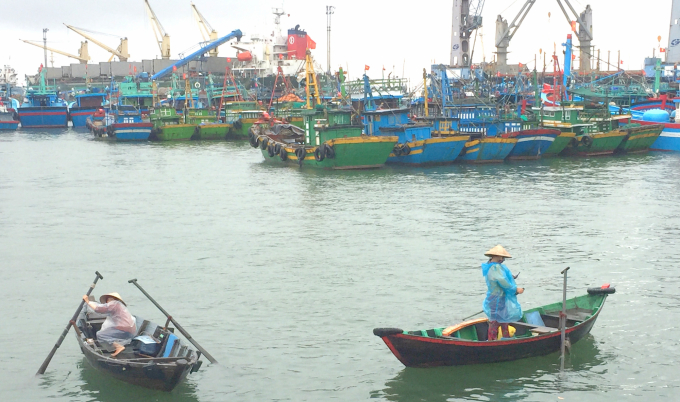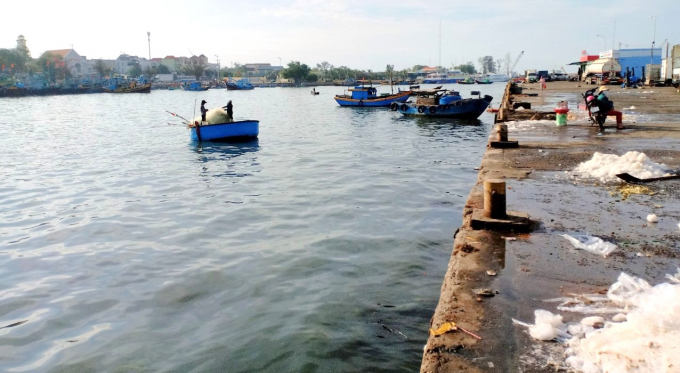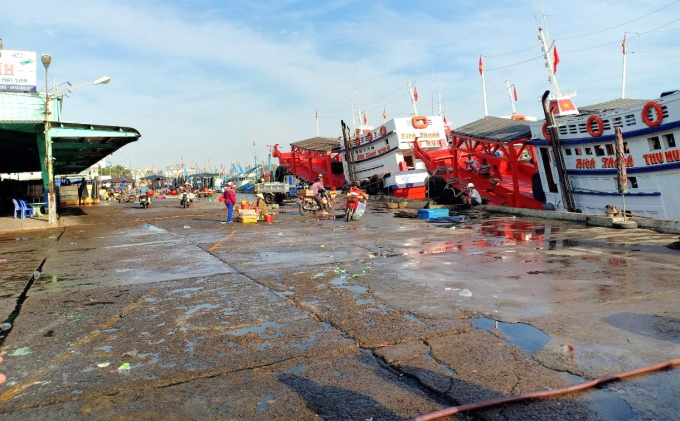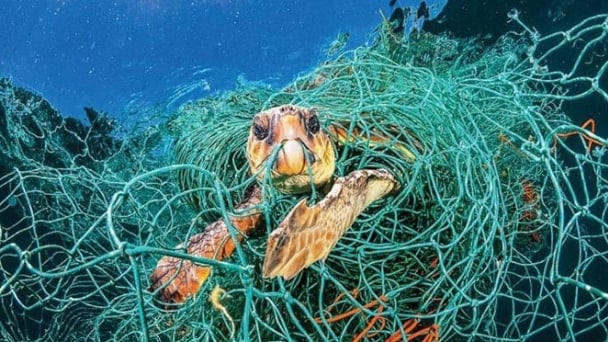June 15, 2025 | 10:21 GMT +7
June 15, 2025 | 10:21 GMT +7
Hotline: 0913.378.918
June 15, 2025 | 10:21 GMT +7
Hotline: 0913.378.918

The water area in Quy Nhon Fishing Port (Binh Dinh) is narrow so fishing vessels have to anchor during the rainy season causing damage from impacts. Photo: Dinh Thung.
According to Mr. Dang Kim Cuong, Director of Ninh Thuan Department of Agriculture and Rural Development, the province has two class II fishing ports: Ninh Chu and Ca Na and two class III fishing ports: Dong Hai and My Tan. However, because the fishing port infrastructure has been in use for a long time, by now, some constructions have severely degraded. The channels and berths of fishing ports are shallow and narrow due to the impact of storms and floods every year. The system of sewage collection ditches, internal roads and wharf grounds are damaged or peeled.
In particular, Dong Hai Fishing Port is a central fishing port for distribution of seafood goods to neighboring localities but the current area is only 1.8 hectares, not meeting the criteria of a class II fishing port requiring a land area of 2.5 ha or more. In addition, the receiving and unloading area of seafood has no roof, affecting the quality of post-harvest product preservation.
“Due to the deteriorating condition, fishing ports in Ninh Thuan have affected fishing vessels in the province arriving and departing the port to buy and sell products. On the other hand, the degraded fishing port infrastructure also affects the environmental sanitation, food safety has not been able to promptly respond to the traceability of seafood after exploitation" said Mr. Dang Kim Cuong, Director of Ninh Thuan Department of Agriculture and Rural Development.
In Phu Yen, according to Mr. Nguyen Tri Phuong, Deputy Director of the Department of Agriculture and Rural Development, the whole province has 4 fishing ports including: Tien Chau, Dan Phuoc, Dong Tac, Phu Lac and 2 fishing wharfs including Xuan Canh, Ward 6. In which, Dong Tac Fishing Port is planned for class I but investment has not met the criteria so it was recognized as class II. This fishing port infrastructure caters for a fleet with the largest length of 12 m or more. However, current limitation in the narrow creeks and channels causing difficulties for vessels to enter and exit but dredging has not yet been carried out.
In Binh Thuan, Phan Thiet Fishing Port is a class I fishing port, put into use since 2000, with 3 zones including: Con Cha Wharf, 40CV Wharf and 400CV Wharf. After many upgrades, the infrastructure of 400CV wharf in Phan Thiet Fishing Port is now mostly complete, however, for the 40CV wharf, the current infrastructure is still outdated, canals are filled, causing difficulties and dangers to fishing vessels entering and leaving this area.
“This wharf has been invested and built for nearly 20 years with a length of 360m. Seven years ago, the wharf was able to meet the capacity of vessels entering and leaving the port, but as time went on, the canals in this area were filled up so it is no longer effective," said a representative of Phan Thiet Fishing Port Management Board.
According to our records, at this wharf area, about 120m has been filled up so no fishing vessels can access. Since then, vessels have to dock at Con Cha wharf causing overload and difficulties in arranging ships for loading and unloading products, especially at the peak of the southern fish season as well as the rainy and stormy season.

40CV Wharf in Phan Thiet Fishing Port (Binh Thuan) is filled, so no vessels can dock or load goods. Photo: Kim So.
As for Quang Nam, fishing ports in the province, while in use for a long time, have not been adequately invested causing constructions to gradually degrade, unable to meet the needs of anchoring and sheltering from storms for vessels as well as loading, unloading, trading activities in aquatic products.
At Tam Ky Fishing Port, An Phu Ward (Tam Ky City, Quang Nam), one of the fishing ports planned to be a class II fishing port in 2020 according to Decision No. 1976/QD-TTg, dated 11/12/ 2015 by the Prime Minister, but by now, the current situation of the port has not seen much change. Meanwhile, the facilities for fisheries logistics such as warehouses and yards after over 10 years of use have begun to show signs of deterioration and disorganized.
Although planned to be a port, in fact, this location is still known by the locals as a fishing wharf. Because so far, Tam Ky fishing port is still only a place for trucks carrying shrimp and fish transported by fishermen in and out of the province and then distributed to markets.
Deputy Minister of Agriculture and Rural Development Phung Duc Tien during a recent business trip to the central provinces assessed that the system of storm shelters and fishing ports nationwide is currently very inadequate, not commensurate with the development of the national fisheries sector, especially when Vietnam's fisheries are transitioning from individual occupations to modern fisheries.
For example, in Binh Dinh, there are 3 fishing ports recognized as class II fishing ports, the province and the Ministry of Agriculture and Rural Development designated them as fishing ports with a system to confirm the origin of fishery products, which are the fishing ports of Quy Nhon (Quy Nhon city), De Gi (Phu Cat district) and Tam Quan (Hoai Nhon town). After upgrading, the three fishing ports have seen better changes but still cannot meet the requirements.
Quy Nhon fishing port was put into operation in 2012. The total water area of the port is 20.6ha, the depth of the channel to the port is 7m, the land area of the port is 3.5ha, equipment mainly for loading and unloading of goods reaches over 70% mechanization, the average number of fishing vessels passing through the port is 10,000 per year, cargo handling capacity is 40,000 tons/year, total output of seafood entering the port is estimated at 37,000 tons/year.

Con Chai wharf in Phan Thiet fishing port (Binh Thuan) is currently very crowded because the 40CV wharf is not effective. Photo: Kim So.
De Gi fishing port was put into operation in 2014. The total water area of the port is over 10ha, the channel depth is 5m, the port land area is 2.5ha, equipment mainly for the loading and unloading of goods reaches over 70% mechanization, the average number of fishing vessels passing through the port is 7,300 per year, cargo handling capacity is 20,000 tons/year, total output of seafood entering the port is estimated at 15,000 tons/year.
Tam Quan Fishing Port has a total water area of 10 hectares, a depth of 5 meters, a land area of 3.8 hectares, equipment mainly for loading and unloading of goods, the number of fishing boats passing through the port is 20,000 per year, capacity of loading and unloading goods is 40,000 tons/year, total output of seafood entering the port is estimated at 20,000 tons/year.
However, according to Mr. Tran Van Phuc, Director of Binh Dinh Department of Agriculture and Rural Development, currently Tam Quan fishing port has been invested and built to meet the conditions for certification of seafood origin. However, there is a serious shortage of logistics and fishery services, resorting to dependence on private fishing wharfs.
“Binh Dinh province currently has nearly 6,000 fishing vessels, excluding about 200-300 fishing boats from other provinces that anchor in the rainy and stormy seasons, but the capacity at anchoring areas can only support about approx. 5,300 ships. Fisheries infrastructure and logistics services have been invested, but not commensurate with the potential for modern fisheries economic development. In particular, the docking areas are currently overloaded, severely lacking capital to invest in the construction and upgrading of fishing port infrastructure and storm shelters to meet standards and the needs of the fishing vessels in the province and the region," said Mr. Tran Van Phuc, director of Binh Dinh Department of Agriculture and Rural Development.
According to the Ministry of Agriculture and Rural Development, in recent years, investment in fishing infrastructure has been low, so 146 ports and storm shelters for vessels and 125 fishing wharves nationwide currently have very inadequate infrastructure. Such disorganized fisheries infrastructure is not suitable for the fishery sector with an output potential of 8.5 million tons/year. Therefore, without infrastructure investment, it will be very difficult to progress to modern fisheries with the goal of international integration.
Translated by Nguyen Hai Long

(VAN) The working delegation from the Ministry of Agriculture and Environment conducted an important trip to the Netherlands to strengthen strategic partnerships and sustainable development in the agricultural sector.

(VAN) The letter ‘A Plea from the Ocean’ not only evokes emotion but also awakens the human conscience to the responsibility of protecting life on Earth.

(VAN) The Department of Agriculture in South Africa has announced the country’s first mass vaccination of poultry to prevent local birds from contracting avian influenza.

(VAN) Establishment of the Mekong Delta Regional Agricultural Linkage Center, aiming for a closed value chain, deep processing, trading platforms, and international market connectivity.

(VAN) Gia Lai province has recently recorded 460 rare species of animals and plants, contributing to forest conservation and biodiversity planning in the region.

(VAN) Ms. Caroline Beresford, New Zealand Ambassador to Vietnam, expressed confidence that agricultural cooperation between Vietnam and New Zealand will develop sustainably, be climate-resilient, and promote gender equality.

(VAN) Vietnam reaffirms its commitment to international cooperation in fostering sustainable and responsible fisheries while ensuring resilient livelihoods for small-scale fishing communities.